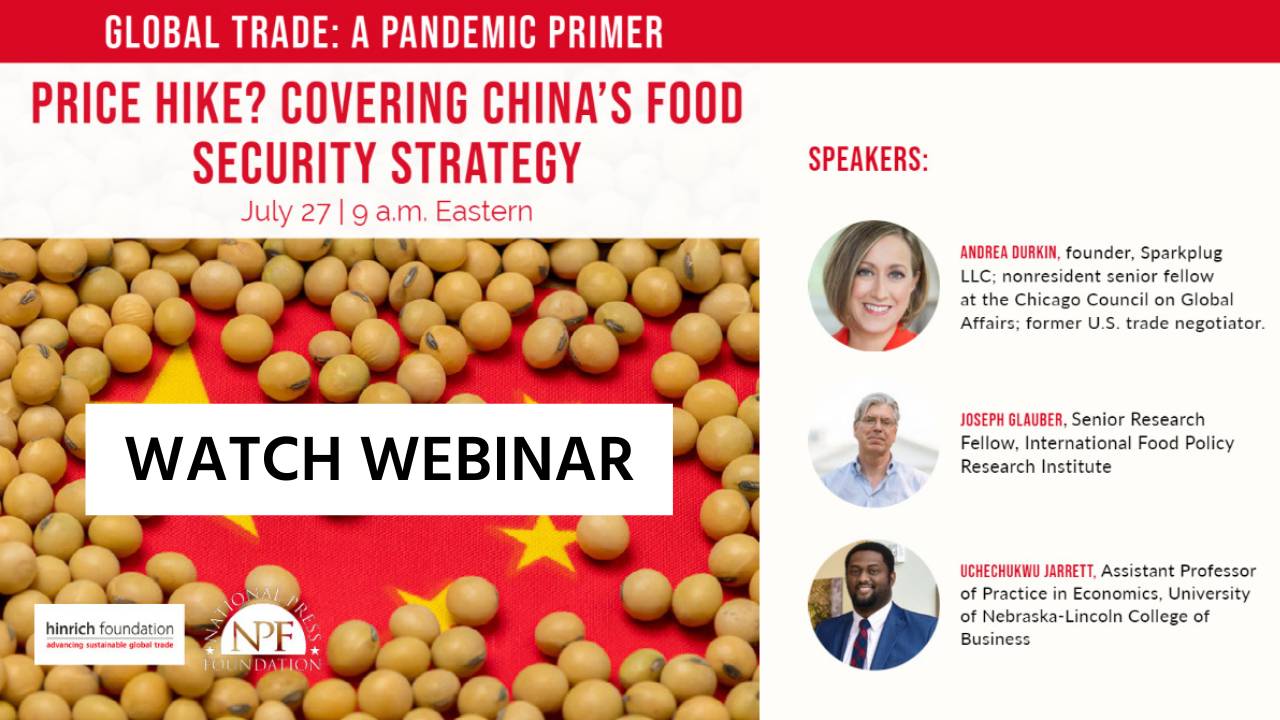Price hike? Covering China’s food security strategy
Published 03 August 2021
As part of the country's five-year plan to achieve "absolute" food security, China's stockpiling of staples in recent years had exacerbated price swings in the global market. Should other nations be worried? Featuring three experts, this National Press Foundation (NPF) webinar looks at China's food security program and its implications for global food trade.
China’s food security policies are part of a longstanding and larger calculus. This Hinrich Foundation-sponsored NPF webinar invited three speakers, including Andrea Durkin, author of "More is less: How China’s policies could weaken global food security", to discuss why Beijing’s vision for how the country will feed itself will affect how the rest of the world does the same. Here are five key takeaways:
- China’s new food security policies could undermine global food security, Andrea Durkin argues. Global food prices are 33.9% higher than last year, even after a dip in June. COVID-19 is one factor, but the cost of food was increasing even before the pandemic, Sparkplug LLC Founder Andrea Durkin said in her new paper. Extreme weather events, pests and animal diseases like African swine flu pushed China to step up grain purchases, particularly of soybeans and maize that were used to feed and rebuild its depleted pig herds. This prompted “unprecedented demand, imports and large swings in the global grain market,” Durkin said. China now produces one-fourth of the world’s grains, and it remains the global market-maker for many commodities. Joseph Glauber, senior research fellow at the International Food Policy Research Institute, argued that demand for food grains will decline over the next few years. “USDA, FAO and OECD are looking at annual increases of about 1%,” Glauber said.
- China’s “No. 1 Policy Document” has four policy levers that will affect global food security, Durkin cites. 1) Increased public spending on price supports and subsidies; 2) Management of central, provincial and local grain stockpiles; 3) Diversification of foreign supply through trade agreements, foreign direct investment overseas and increased control of global distribution; 4) Accelerated innovation and use of advanced seed technologies. Durkin reported that China controls half of the global grain reserves, leaving less for food security in other countries. “The focus is on grains, wheat, rice, maize and soybeans. These are the most heavily traded, and this is how Beijing defines absolute food security and self-sufficiency,” Durkin said.
- China’s spending could set off an arms race in agricultural subsidies. According to the Organization for Economic Co-operation and Development, China spent $185.9 billion in farm subsidies in 2019, making it the world’s largest subsidizer of agriculture. This amount is almost four times the amount spent by the U.S. and more than the EU, the U.S. and Japan combined, Durkin said. “China is consistently exceeding its World Trade Organization commitments, which are to keep its spending to 8.5% of its production value.” China intends to increase subsidies for inputs on fertilizers, fuel, seeds, farm machinery, as well as raise the amount of support to farmers through crop insurance programs, Durkin added.
- China’s farmland purchases in Africa aren’t a big concern, but contract farming may be a danger zone for African farmers. Glauber said he doesn’t see competition threats from China, and land acquisition is minor in areas like the U.S. and Africa. Uchechukwu Jarrett, who teaches trade at the University of Nebraska-Lincoln, agreed and said that Africa has about 60% of the world’s unused arable land, but it can’t meet 25% of its yield capacity. “There’s an abundance of resources yet a shortage of an ability to take advantage of those resources, which is inviting a lot of foreign interests,” Jarrett said, But China and other foreign contracts with African farmers are a concern because they use a “right of first refusal,” strategy that limits competition and negotiation. Jarrett says vulnerable farmers could be taken advantage of.
- Transparency is crucial. Durkin urges China to make information available about its grain reserves and the subsidies provided through its price support programs. “The lack of transparency has allowed China to exceed its WTO commitment to limit agricultural subsidies, prompting the U.S. lawsuit with China for failing to comply,” the paper said. Proceedings are ongoing, but the U.S. is requesting increased tariffs on $1.3 billion of imports from China, Durkin said. “When you look at the volumes of what’s traded, that helps countries ride out the local regional shocks from drought or other major events and allows the markets to function well.” Without transparency and market intervention, markets don’t function well, she added.
***
Telling the global trade story
This briefing is part of a series of National Press Foundation's online webinars covering all aspects of global trade.
© The Hinrich Foundation. See our website Terms and conditions for our copyright and reprint policy. All statements of fact and the views, conclusions and recommendations expressed in this publication are the sole responsibility of the author(s).





